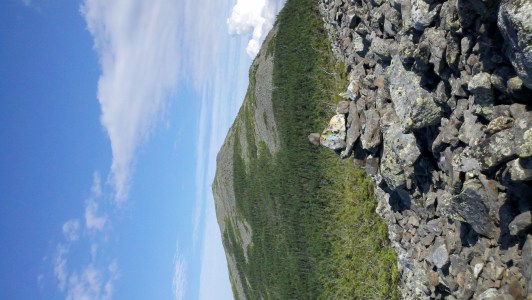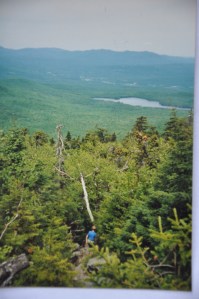From leisurely woods walks to rugged mountain rock scrambling, there’s something for all hiking abilities and tastes in western Maine.
There are countless trails to choose from in Franklin County. For avid peakbaggers, 10 of the state’s 14 peaks over 4,000 feet are located in the region. What follows is a list of trails for different hiking abilities.
Piazza Rock
3.4 miles round trip
Level of difficulty: Easy
Piazza Rock is a giant granite monolith located just off the Appalachian Trail in Sandy River Plantation. To get there, take Route 4 north from Farmington or south from Rangeley. The trail leaves the parking area on Route 4 9.5 miles south of Rangeley or 2.5 miles north of the center of Madrid.
You will go downhill for a bit, cross the Sandy River on a bridge, and go up a steep embankment on the other side. From here, the trail proceeds through a mixed growth forest, and crosses a logging road in another .5 mile.
After passing through a blowdown area, the trail makes several small ups and downs, and crosses the old route of the AT coming down from the Sandy River ponds. A trail register is passed, and a small stream is crossed, before the trail arrives at the junction with the spur trail to Piazza Rock. Go left here, and uphill, and you will come upon the massive, house-sized boulder. There are several side trails where you can climb up onto the rock to get a view.
Bald Mountain
2 miles round trip
Level of difficulty: Easy
There are numerous mountains in Maine named Bald. This one is located in Oquossoc. To get there, head west from Rangeley on Route 4 to Haines Landing. Turn left, and travel one mile to the parking area on the left.
Boggy sections characterize the lower part of the trail. Waterbars, bog bridges, and stone steps help keep your feet dry, although there’s still some muddy sections to look out for. After about half a mile, the trail turns uphill, varying from gentle to moderately steep grades. Keep right at a fork in the trail, climbing over several ledges. The trail flattens, and then breaks into the summit clearing.
A fire tower offers fabulous 360-degree views on a clear day. Rangeley, Richardson, Mooselookmeguntic, and Cupsuptic are just some of the lakes that can be seen. There are also mountains extending north to the Canadian border that stand sentinel over the valleys.
Low Aziscoos Mountain
3 miles round trip
Level of difficulty: Easy
Aziscoos is located near the Maine-New Hampshire border, looming over Route 16. The trailhead is reached by taking Route 16 from Oquossoc and traveling to a point one mile east of Aziscoos Dam and 2.3 miles east of Wilson’s Mills. Park in the turnout on the south side of the road.
The trail leaves the road on the south side at an “Aziscoos Mountain Trail” sign. It passes through boggy terrain, where the tracks of bear, deer, moose, and other animals can be seen. At about .7 mile from the road, the trail starts climbing in earnest, winding sidehill across the mountainside.
The walking is through mainly evergreens as the trail makes a short scramble over boulders before reaching a junction with an old trail from the east at 1.4 miles. Turn left here, and you’ll come out onto the semi-open lower summit, which used to have a firetower on top. Only the fire tower’s footings remain, but Aziscoos still boasts some of the best lake views in Maine.
Mt. Blue
3.4 miles round trip
Level of difficulty: Moderate
Mt. Blue is one of the most prominent peaks in the area, standing apart from other mountains and distinguished by its gumdrop-like form. To get there, head east from Route 156 in Weld on the paved road by the general store. Keep left at the first junction. The road becomes gravel and passes the Center Hill access road on the right. Keep right at the next junction, and you will come to the parking area six miles from Weld.
This trail features steady, moderately steep climbing all the way to the summit. It passes by the site of the former fire warden’s cabin on the left at a little over one mile, where there is a spring.
From here, the trail gets steeper, passing from deciduous growth into evergreens. You’ll come out on the summit (3,187 feet), which has an open grassy area perfect for picnicking and the remains of the old fire tower. There are several overlooks where you can get views.
Tumbledown Mountain
5 miles round trip (Brook Trail) or 6 miles round trip (Loop Trail and Brook Trail circuit)
Level of difficulty: Moderate (Brook Trail) or strenuous (Loop Trail)
Tumbledown Mountain offers a fascinating variety of mountain terrain, and is one of the most popular hiking peaks in the region. There is a jewel-like alpine lake between the summits which swimmers frequent in the summer.
To get there, travel north on Route 142 from Weld toward Phillips, and take the road to Webb Lake from Weld corner. About 2.3 miles past this point, head straight on the gravel Byron Road. Stay on the road for six miles until you reach the Brook Trail parking area on your left.
The trail leaves across the road, and heads up an old logging road. The climbing is gradual, and a stream is crossed partway up. Eventually, the road levels before ending at one mile. Turn left here, and proceed up a new section of trail constructed by the Maine Conservation Corps in 2009 to replace an eroded trail section.
The new section climbs moderately for a few hundred yards before rejoining the former section. Tumbledown Brook is crossed twice, and several scrambles over roots and boulders lead the hiker to Tumbledown Pond at 1.5 miles.
From here, turn left, and ascend the east and west peaks of the mountain. There are several ledgy areas which are slippery in wet conditions, so use caution. The west peak has views of New Hampshire’s White Mountains on a clear day.
For a more strenuous hiking experience, the Loop Trail is the place to be. Please note, though, that the trail is not suitable for small children or dogs due to some steep rock scrambles.
The trailhead is located about one mile past the Brook Trail parking area. It leaves the left side of the road, and starts out level, but soon ascends an embankment and crosses a small stream.
It passes one boulder balanced on top of another at .4 mile, and an enormous house-sized boulder at .9 mile.
The trail climbs very steeply .3 mile over rocks and roots until it reaches a flat, ledgy area. From here, Tumbledown’s enormous cliffs can be seen. The trail crosses a little brook, and then begins climbing increasingly steeply until it reaches what appears to be a dead end. Here, there is a boulder cave to climb through. Ladder rungs aid passage through the rocks.
Just above this section, a junction with the trail along the ridge is reached. Turn left for the west summit or right for the east summit and pond. Many people like to do this as a loop, ascending the Loop Trail and descending the Brook Trail.
Little Jackson
6.5 miles round trip
Level of difficulty: Moderate
Little Jackson overlooks Tumbledown Pond, and has an extensive area of alpine vegetation. The summit has 360-degree views.
Take the Byron Road about three miles until you come to the trailhead on the left. Go up this road about one mile, traveling steeply up a hill to reach the parking area. The trail leaves left.
Walk .3 mile to a junction; stay to the right here. The trail climbs gradually up to an old logging road before leveling out briefly and reaching a junction with the Pond Link Trail to Tumbledown Pond. Turn right here and cross a couple of streams and wet areas.
The steepest part of climbing lasts for .25 mile before the trail abruptly breaks out above treeline. Here, there is a junction with the trail to Big Jackson. The Little Jackson trail goes left and winds up through the ledges, with one or two short descents into hollows. Care must be taken to follow the cairns and paint blazes, particularly in foggy weather.
Bigelow Range Loop
11 miles round trip
Level of difficulty: Strenuous
Bigelow is one of Maine’s most recognizable mountains, with two distinct peaks and two “horns” on the ridge. It is also one of the more challenging hikes in the state, as there are prolonged steep sections on the trails and the open summits are fully exposed to the brunt of the prevailing northwest winds. Be prepared for cold weather at any time of the year.
This is a loop that will incorporate the Firewarden’s Trail and part of the Appalachian Trail. To get there, head north on Route 16/27 from the Sugarloaf access road for 3.3 miles, or 4.5 miles south of Stratton. Turn right on a dirt road. The road is rough in places, but can be driven to the parking area.
Walk down and cross a stream, and then proceed on the level for a short distance. You’ll cross a brook, and then start climbing, gradually at first.
The mile of trail before reaching the sag between West and Avery peaks is the steepest of the trip. Rock steps and ladders make the passage easier going up the steep slope. You’ll reach a tentsite on your right just before reaching a junction with the Appalachian Trail.
Turn right to go to Avery Peak. There was once a firewarden’s lookout here, but it no longer remains. However, what do remain are 360-degree views encompassing Flagstaff Lake and the surrounding 4,000-foot peaks.
Retrace your steps to the junction, and then climb to West Peak. Views here are equally outstanding.
Descend steeply into a col, and then climb to South Horn, where there are some more fine views. A short spur trail just below South Horn leads to North Horn, for more excellent views.
Descend moderately, and reach Horns Pond and the shelters and campsite. This is a popular overnight destination for Appalachian Trail thru-hikers.
Take the Horns Pond Trail just beyond the shelters, which leaves left and will lead you back to your starting point. This trail descends moderately to gradually through a forest with a wide array of tree species, plus some interesting marshes and boggy areas where wildlife can be seen. After about 2.5 miles of hiking, you’ll rejoin the Firewarden’s Trail. Turn right, and walk back to your starting point.
Mt. Abraham
9.5 miles round trip
Level of difficulty: Strenuous
Mt. Abraham has a series of summits that extend along a ridge overlooking Kingfield. The tallest of these is 4,049 feet.
Travel on Route 16/27 to get to Kingfield, and go beyond the town center .3 mile to the West Kingfield Road. Turn left, and go down this road 3.5 miles to where it divides. It is somewhat rough here, so cars with low clearance should use caution. Go straight ahead, and stay on the road until you come to a washed out bridge over Rapid Stream on your left. Find a spot off the road to park, cross the stream, and walk half a mile down the old logging road until you spot the trail going into the woods straight ahead of you.
From this point, the trail crosses Norton Brook and climbs the bank above it. It then passes through an extensive boggy area, and crosses a logging road. The trail reaches the firewarden’s cabin in a clearing.
Here, the terrain changes suddenly. The trail gains about 1,000 feet in the next mile, passing through several S-turns. It comes out above treeline for the final quarter mile, passing over loose rock. At the summit, there are the remains of a fire tower. Views of Kingfield and the surrounding mountains make this a memorable hike.
Saddleback and the Horn
14.8 miles round trip
Level of difficulty: Strenuous
This is one of New England’s premier ridge walks. It is also very open and exposed to the weather, so bring warm clothing at all times of the year and watch out for thunderstorms during the warmer months.
You’ll leave from the same trailhead as the Piazza Rock hike. Beyond Piazza Rock, pass a path to a lean-to on your right and then climb a steep ridge to Ethel Pond.
You’ll walk around the pond’s rugged shoreline, and then go into thick woods, crossing a small brook and climbing gradually past Mud Pond on the left. More level woods walking brings the hiker to scenic Eddy Pond.
The trail crosses a logging road and climbs moderately up the slope. It then starts climbing more steeply and emerges on open ledges. The slope levels and the trail traverses Saddleback’s ridge, dipping into the “saddle” before rising gently to the summit. After taking in the views, continue on the trail and descend into the col between Saddleback and the Horn. The trail winds up the Horn’s ledges, and shortly thereafter comes to the open summit. Both peaks are more than 4,000 feet in elevation.








Comments are no longer available on this story